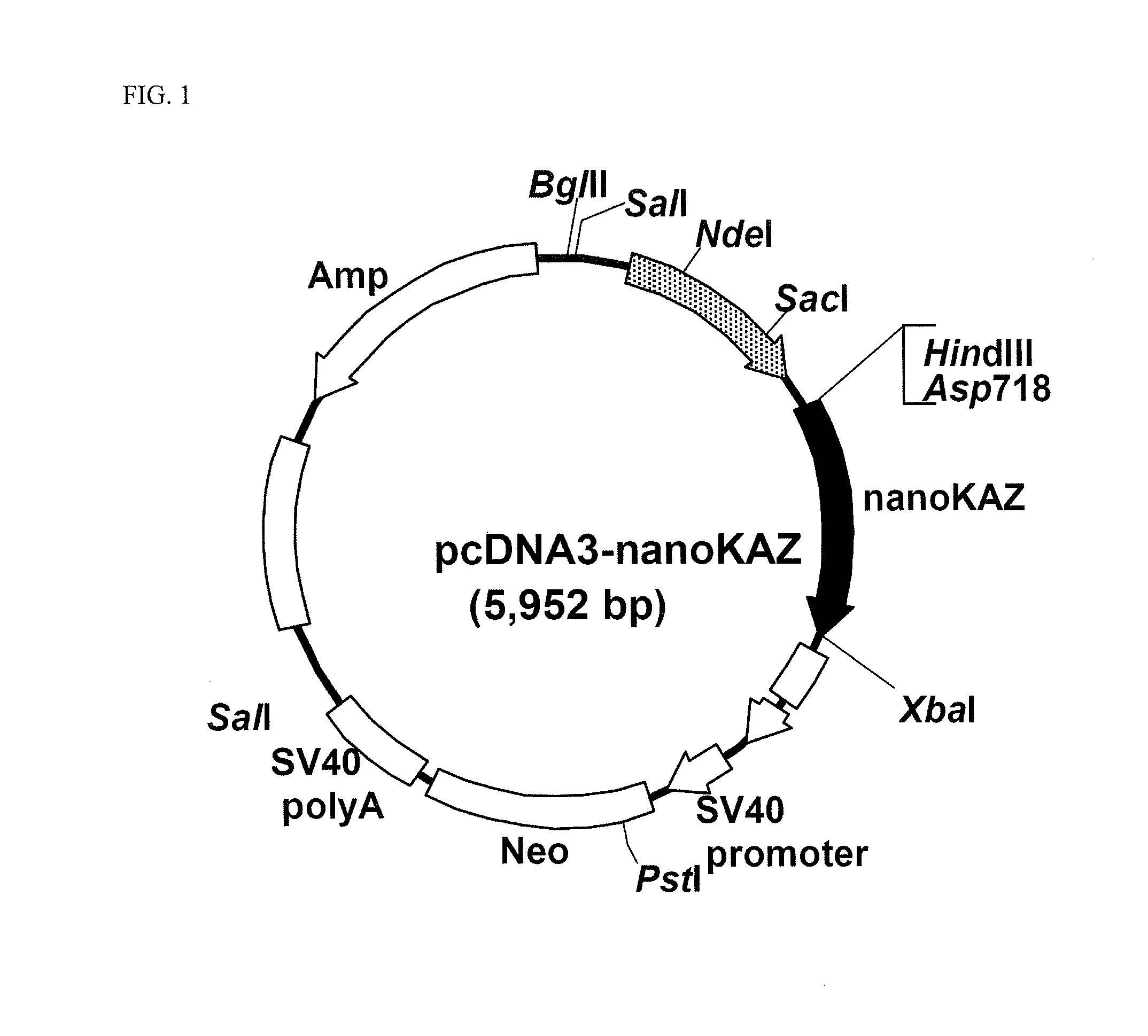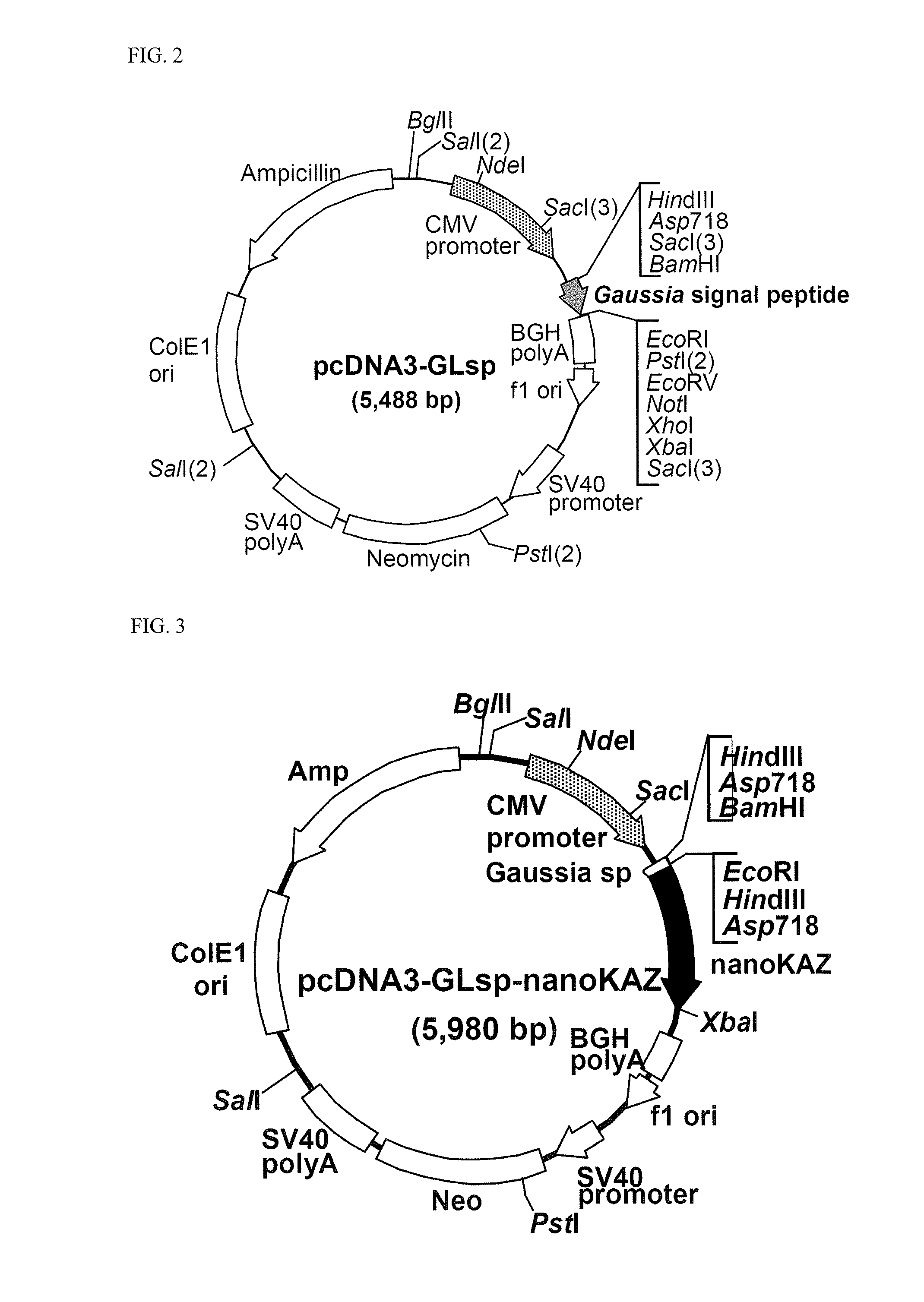Codon-optimized gene for mutated shrimp luciferase and method for use thereof
a technology of luciferase and codon, which is applied in the field of codon-optimized gene for the mutated catalytic domain of shrimp luciferase, can solve the problems of unclear function of mutated amino acid residues and achieve the effect of higher activity
- Summary
- Abstract
- Description
- Claims
- Application Information
AI Technical Summary
Benefits of technology
Problems solved by technology
Method used
Image
Examples
example 1
Design and Chemical Synthesis of Codon-Optimized Nucleic Acid
[0183]Based on the amino acid sequence (SEQ ID NO: 1) of the catalytic 19 kDa domain (sometimes simply referred to as nanoLuc) in the mutant Oplophorus luciferase from Promega Corp. generated by mutagenesis of the catalytic 19 kDa domain (sometimes simply referred to as nanoKAZ) of native Oplophorus luciferase, a gene for the mutated catalytic 19 kDa domain (sometimes simply referred to as nanoKAZ) of the codon-optimized Oplophorus luciferase was designed. Specifically, the nucleotide sequence (SEQ ID NO: 2) of nanoKAZ was designed by applying only the amino acid codon frequently used in human without changing the amino acid sequence (SEQ ID NO: 1) of nanoLuc. The codon usage frequency of the nanoKAZ domain is shown in TABLE 1. Obviously, the codon-optimized nanoKAZ domain nucleic acid was designed by adopting only the amino acid codon frequently used in human. The gene optimally designed for the codon-optimized nanoKAZ do...
example 2
Construction of Vector for Secretion and Expression of Codon-Optimized nanoKAZ Domain Protein in Cultured Animal Cells
[0186](1) Expression Vector for Secretory Expression of Codon-Optimized nanoKAZ Domain Protein without a Signal Peptide Sequence for Secretion
[0187]The gene fragment for the codon-optimized nanoKAZ domain containing a Kozak sequence was digested with the restriction enzymes of Asp817 and XbaI, and inserted into the Asp817-XbaI site of pcDNA3 vector (manufactured by Invitrogen Inc.) to construct pcDNA3-nanoKAZ vector (FIG. 1).
[0188]The nucleotide sequence of nanoKAZ encoded in the expression vector pcDNA3-nanoKAZ is shown in SEQ ID NO: 2 and its amino acid sequence in SEQ ID NO: 1.
(2) Expression Vector for Secretory Expression of the Codon-Optimized nanoKAZ Domain Protein with a Signal Peptide Sequence for Secretion of Gaussia Luciferase
[0189]The vector for expressing the codon-optimized nanoKAZ domain protein was constructed as follows. Firstly, a novel expression ve...
example 3
Transfection of Vector into Cultured Animal Cells and Preparation of Enzyme for Assay
(1) Purification of Expression Plasmid
[0192]Using the plasmids pcDNA3-nanoKAZ and pcDNA3-GLsp-nanoKAZ obtained in EXAMPLE 2, the following experiment was carried out. The plasmids pcDNA3-nanoKAZ and pcDNA3-GLsp-nanoKAZ were purified from Escherichia coli JM83 using a Plasmid Purification Kit (manufactured by QIAGEN Inc.) and dissolved in sterile water to a concentration of 1 μg / μL. Following by the similar procedures, firefly luciferase vector (pGL4.13 [Luc2 / sv40]: manufactured by Promega Corp.) was used as an internal standard.
(2) Transfection and Preparation of Enzyme for Assay
[0193]CHO—K1 cell line derived from Chinese hamster ovary was cultured in Ham's F-12 medium (manufactured by Wako Pure Chemical Industries, Ltd.). containing 10% (v / v) fetal bovine serum (manufactured by Biowest Inc.), and HeLa cell line derived from human uterine cervical cancer cells and COS-1 cell line derived from Africa...
PUM
| Property | Measurement | Unit |
|---|---|---|
| Fraction | aaaaa | aaaaa |
| Fraction | aaaaa | aaaaa |
| Fraction | aaaaa | aaaaa |
Abstract
Description
Claims
Application Information
 Login to View More
Login to View More - R&D
- Intellectual Property
- Life Sciences
- Materials
- Tech Scout
- Unparalleled Data Quality
- Higher Quality Content
- 60% Fewer Hallucinations
Browse by: Latest US Patents, China's latest patents, Technical Efficacy Thesaurus, Application Domain, Technology Topic, Popular Technical Reports.
© 2025 PatSnap. All rights reserved.Legal|Privacy policy|Modern Slavery Act Transparency Statement|Sitemap|About US| Contact US: help@patsnap.com



